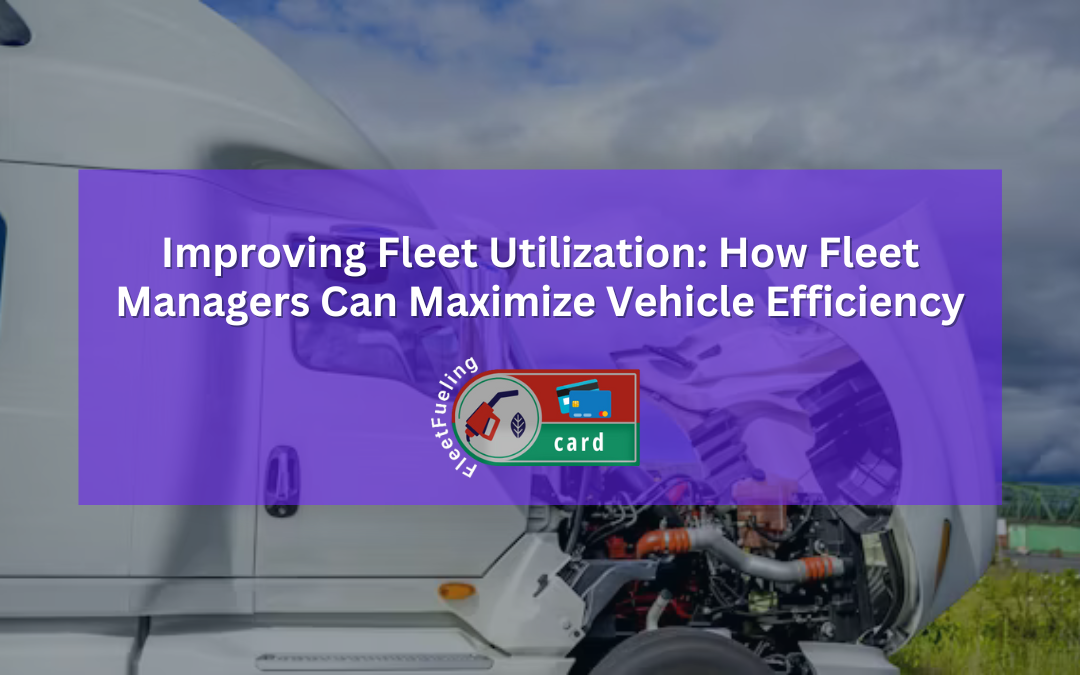Fleet managers often face the challenge of ensuring their vehicles are used efficiently to avoid unnecessary costs and maximize profitability. Proper fleet utilization is a key aspect of optimizing operations and driving overall business success. Whether it’s ensuring that vehicles are always in use, minimizing downtime, or utilizing the right vehicle for the job, maximizing fleet utilization directly impacts the bottom line.
In this article, we will explore the importance of fleet utilization, strategies for improving it, and how technology can assist fleet managers in getting the most out of their assets. From fleet tracking systems to driver behavior monitoring, we will discuss the best practices for improving vehicle usage and streamlining fleet operations.
The Impact of Fleet Utilization on Business Operations
Fleet utilization refers to the extent to which a company’s vehicles are used compared to their full potential. When fleet utilization is low, businesses may face higher costs due to underused assets, increased maintenance costs, and wasted fuel. On the other hand, high fleet utilization maximizes the efficiency of each vehicle, reduces idle time, and ensures that every vehicle is contributing to the company’s productivity.
Improving fleet utilization can have a significant impact on a company’s overall profitability. The more efficiently a fleet operates, the fewer vehicles a business needs, which can lead to cost savings on both vehicle acquisition and maintenance. Additionally, vehicles that are used efficiently experience less wear and tear, which extends their lifespan and reduces costly repairs. Efficient fleet utilization also ensures that drivers are being productive, reducing the need for overtime and improving overall operational effectiveness.
For fleet managers, improving fleet utilization is about finding the right balance—making sure that vehicles are being used to their fullest potential without overburdening the fleet, leading to higher operational costs.
Effective Strategies to Maximize Fleet Utilization
-
Optimize Fleet Scheduling and Route Planning
One of the most effective ways to improve fleet utilization is through efficient scheduling and route planning. By ensuring that vehicles are used during peak hours and assigned the most effective routes, fleet managers can maximize the value of their fleet assets.
Route optimization tools can help fleet managers determine the most efficient paths for their drivers, saving time, fuel, and reducing the risk of delays. Fleet management software can provide real-time data to identify traffic patterns, road conditions, and the fastest routes. This ensures that drivers are taking the best possible routes, reducing idle time and fuel consumption while improving vehicle utilization.
Scheduling software can also ensure that the right vehicle is assigned to the right job at the right time, preventing underutilization or overuse of specific vehicles. For example, assigning larger trucks to jobs that require heavy hauling and reserving smaller vehicles for more local trips ensures that the fleet is optimized for each task. By making use of every vehicle in the fleet and reducing idle time, fleet managers can increase overall productivity.
-
Leverage Telematics for Real-Time Tracking and Data Insights
Telematics technology is a game changer when it comes to improving fleet utilization. GPS tracking, along with real-time telematics, allows fleet managers to monitor vehicle locations, fuel consumption, and overall performance. With this data, fleet managers can ensure that vehicles are being used efficiently and are on the road when needed.
Telematics systems can provide detailed insights into vehicle performance, such as excessive idling, frequent stops, or low fuel efficiency. By identifying patterns of inefficiency, fleet managers can take action to adjust routes, optimize schedules, and minimize idle time. Additionally, telematics systems allow fleet managers to track maintenance needs, ensuring that vehicles are always in optimal condition and ready for use when required.
By analyzing real-time data, fleet managers can also identify underutilized vehicles. This allows businesses to make informed decisions about whether to sell or replace certain vehicles, reducing the number of vehicles on the road and lowering operational costs.
-
Implement a Preventive Maintenance Program to Reduce Downtime
Downtime is one of the most significant obstacles to maximizing fleet utilization. When vehicles are out of service for maintenance or repairs, it disrupts the entire operation and reduces the overall productivity of the fleet. Fleet managers can combat this by implementing a preventive maintenance program that ensures vehicles are serviced before they break down.
Preventive maintenance includes tasks such as regular oil changes, tire checks, brake inspections, and engine tune-ups. By keeping vehicles in top condition, fleet managers can reduce the likelihood of unexpected breakdowns and minimize the amount of time vehicles spend in the repair shop. Scheduled maintenance also helps to extend the lifespan of fleet vehicles, allowing the company to get the most value out of each asset.
Fleet management software can be used to track the maintenance schedules of each vehicle in the fleet, sending reminders when it’s time for service. This helps ensure that all vehicles remain operational and available for use, contributing to better fleet utilization.
-
Monitor and Improve Driver Behavior
Driver behavior plays a key role in fleet utilization. Poor driving habits—such as speeding, hard braking, and excessive idling—can waste fuel, increase wear and tear on vehicles, and reduce overall fleet efficiency. Fleet managers should invest in driver behavior monitoring programs to identify and address these issues.
Telematics and GPS tracking systems can monitor key driving metrics, such as speed, braking, and idling. This data can be used to provide feedback to drivers and offer training on how to drive more efficiently. Encouraging drivers to adopt habits that reduce fuel consumption and wear on the vehicle can lead to higher fleet utilization, as vehicles will require less maintenance and experience fewer breakdowns.
By improving driver behavior, fleet managers can also reduce the risk of accidents and damage to the vehicles. Safe driving practices not only extend the lifespan of fleet vehicles but also ensure that vehicles are available for use more frequently.
-
Use Data Analytics to Improve Fleet Performance
Fleet performance data is invaluable when it comes to improving fleet utilization. By analyzing data on vehicle usage, fuel consumption, and driver behavior, fleet managers can identify inefficiencies and make data-driven decisions to improve operations.
Fleet management software typically includes analytics tools that allow fleet managers to track key performance indicators (KPIs), such as vehicle utilization rates, fuel economy, and maintenance costs. By monitoring these metrics, fleet managers can identify trends and patterns that may indicate underutilization or inefficiencies in fleet operations.
Analytics can also help fleet managers make decisions about fleet composition. For example, if certain vehicles are consistently underutilized, it may be more cost-effective to dispose of them and invest in more versatile vehicles. On the other hand, if certain vehicles are consistently overused, it may be time to invest in additional assets to reduce the strain on existing vehicles.
The Full Potential of Vehicle Your Fleet
Maximizing fleet utilization is essential for fleet managers who want to improve efficiency, reduce costs, and drive profitability. By implementing strategies such as optimizing scheduling, using telematics to track performance, prioritizing preventive maintenance, and improving driver behavior, fleet managers can get the most out of their vehicles and increase productivity across the fleet.
Leveraging data analytics and fleet management software further enables fleet managers to make informed decisions about how to improve operations and ensure that every vehicle in the fleet is contributing to the business’s success. Through careful planning, data-driven decision-making, and the use of technology, fleet managers can unlock the full potential of their fleet, boosting efficiency and profitability while keeping operational costs under control.
With the right strategies in place, fleet managers can ensure that their fleet is working at maximum capacity, providing reliable service to customers, reducing costs, and driving business growth.


**mind vault**
mind vault is a premium cognitive support formula created for adults 45+. It’s thoughtfully designed to help maintain clear thinking
**prostadine**
prostadine is a next-generation prostate support formula designed to help maintain, restore, and enhance optimal male prostate performance.
**sugarmute**
sugarmute is a science-guided nutritional supplement created to help maintain balanced blood sugar while supporting steady energy and mental clarity.
**glpro**
glpro is a natural dietary supplement designed to promote balanced blood sugar levels and curb sugar cravings.
**zencortex**
zencortex contains only the natural ingredients that are effective in supporting incredible hearing naturally.
**mitolyn**
mitolyn a nature-inspired supplement crafted to elevate metabolic activity and support sustainable weight management.
**prodentim**
prodentim an advanced probiotic formulation designed to support exceptional oral hygiene while fortifying teeth and gums.
**yusleep**
yusleep is a gentle, nano-enhanced nightly blend designed to help you drift off quickly, stay asleep longer, and wake feeling clear.
**vittaburn**
vittaburn is a liquid dietary supplement formulated to support healthy weight reduction by increasing metabolic rate, reducing hunger, and promoting fat loss.
**synaptigen**
synaptigen is a next-generation brain support supplement that blends natural nootropics, adaptogens
**nitric boost**
nitric boost is a dietary formula crafted to enhance vitality and promote overall well-being.
**glucore**
glucore is a nutritional supplement that is given to patients daily to assist in maintaining healthy blood sugar and metabolic rates.
**wildgut**
wildgutis a precision-crafted nutritional blend designed to nurture your dog’s digestive tract.
**pinealxt**
pinealxt is a revolutionary supplement that promotes proper pineal gland function and energy levels to support healthy body function.
**energeia**
energeia is the first and only recipe that targets the root cause of stubborn belly fat and Deadly visceral fat.
**boostaro**
boostaro is a specially crafted dietary supplement for men who want to elevate their overall health and vitality.
**prostabliss**
prostabliss is a carefully developed dietary formula aimed at nurturing prostate vitality and improving urinary comfort.
**potentstream**
potentstream is engineered to promote prostate well-being by counteracting the residue that can build up from hard-water minerals within the urinary tract.
**breathe**
breathe is a plant-powered tincture crafted to promote lung performance and enhance your breathing quality.
**hepatoburn**
hepatoburn is a premium nutritional formula designed to enhance liver function, boost metabolism, and support natural fat breakdown.
**hepatoburn**
hepatoburn is a potent, plant-based formula created to promote optimal liver performance and naturally stimulate fat-burning mechanisms.
**cellufend**
cellufend is a natural supplement developed to support balanced blood sugar levels through a blend of botanical extracts and essential nutrients.
**prodentim**
prodentim is a forward-thinking oral wellness blend crafted to nurture and maintain a balanced mouth microbiome.
**flowforce max**
flowforce max delivers a forward-thinking, plant-focused way to support prostate health—while also helping maintain everyday energy, libido, and overall vitality.
**neuro genica**
neuro genica is a dietary supplement formulated to support nerve health and ease discomfort associated with neuropathy.
**revitag**
revitag is a daily skin-support formula created to promote a healthy complexion and visibly diminish the appearance of skin tags.
**sleeplean**
sleeplean is a US-trusted, naturally focused nighttime support formula that helps your body burn fat while you rest.
**memory lift**
memory lift is an innovative dietary formula designed to naturally nurture brain wellness and sharpen cognitive performance.
lnuquiwef euner scqeiba nouq ixllpyacdngtyju